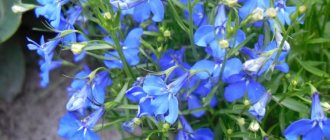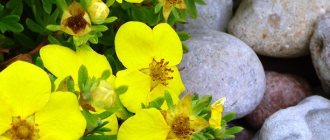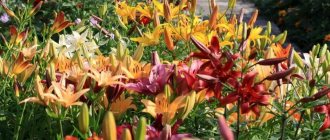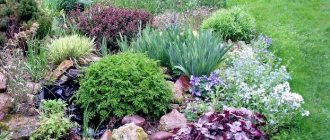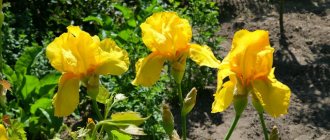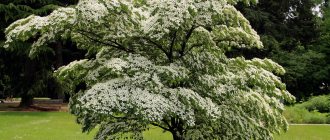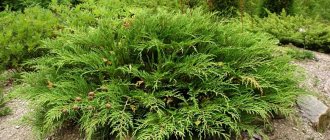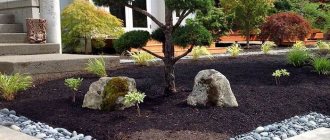Daylily is a fairly commonly used plant in landscape design. This is due to a number of its positive characteristics, the ability to combine with other plants and create magnificent combinations in the landscape of a summer cottage and a country house.
Daylily is one of those flowers that will decorate any garden for a long time, and without much labor.
Use in landscape design
Daylilies are a perennial crop, so when planting them, you need to carefully consider the planting location and combination with other plants. At the same time, the large varietal diversity of this flower makes it possible to achieve a variety of effects in your flowerbed. Therefore, it is worth getting to know this ornamental plant better.
Daylilies are so versatile that they can be used in a wide variety of garden arrangements.
Daylily is a herbaceous crop that grows in one planting site for several years. Belongs to the lily family and is native to the eastern regions of Asia.
One daylily flower is short-lived, but new buds bloom to replace the fading ones
When daylilies fade, their foliage also plays a role in the design of the site
The features of this type of plant are as follows:
- Unpretentiousness, which makes flower beds with daylilies an ideal solution for garden plots where it is not possible to devote a large amount of time to planting.
- To achieve maximum effect and not spend a lot of time and effort, you should choose varieties that were bred quite a long time ago. In this case, there is a high probability of plant resistance to many negative conditions.
Varieties of different colors react differently to sunlight - The flowers are funnel-shaped and located in the upper part of the plant. Their colors can be very diverse and not only monochromatic, but combine several shades at once. But still, the most common colors are orange, brown, red and yellow in the color of the petals.
- From 1 to 3 flowers bloom on one plant at the same time.
- When arranging a landscape design with daylilies, you first need to pay attention to the timing of their flowering. You can select early, middle and late varieties, simultaneously achieving the transition of flowering from one plant to another.
The flowering time of daylilies varies depending on the species - from April to July
The plant tolerates winter quite well if there is snow cover. In this case, it does not require additional shelter.
Species
The entire huge number of modern daylily varieties, united under the general name hybrid daylily, were obtained from just a few wild species. At the same time, gardeners do not refuse to grow species of hemerocallis in their flower beds.
Properly selected in accordance with the conditions of the site, these will be completely problem-free plants that grow quickly and bloom for a long time.
If orange-red flowers on tall peduncles peek out from behind the fence, we can say with almost one hundred percent certainty: this is a brown-yellow daylily. The most common, unpretentious and abundantly flowering species. This powerful, fast-growing plant can even cope with weeds on its own!
When a lot of varietal daylilies appear in the garden over time, the former favorite of the place already feels sorry for it - and its bushes, at best, are planted behind the fence, or at worst, they are simply thrown away.
Middendorff daylily is somewhat less common in gardens. It can be identified by the abundance of bright golden-yellow flowers that appear on the bushes from the end of May. The flowers have a pleasant, unobtrusive aroma.
The lemon-yellow daylily species can be considered a rarity - its tall, strong peduncle can bear up to 65 graceful flowers, exuding a pleasant citrus aroma. The leaves are also good: narrow with a bluish coating. If you manage to get such a plant, it is worth planting it near your resting place.
Varieties and varieties of daylilies
Daylilies, in addition to their flowering period, can also be divided into:
- Wild.
- Hybrid varieties. These, in turn, are divided into partially evergreen, evergreen and dormant subspecies.
According to the shape of the flowers there are:
- Simple rounded.
- Star-shaped.
- Triangular shape.
- Insect-like with thin leaves.
- Terry, that is, having several layers of petals.
Terry daylily variety Roswitha - Fringed - those that have an uneven edge dotted with small slits.
Angel of Light daylily with ruffled petals
According to the color scheme we can distinguish:
- Plain. There are 18 primary colors here, with the possible exception of blue shades.
- With mixed colors. The most popular and spectacular varieties are those with the names “Orange”, “Yellow”, “Dumortier”, “Heucher”.
Variety Cool It
Variety Frans Halls
Variety King of Hearts
Japanese variety Kwanzo
Variety Radiant Greetings
Variety “Viking Magic”
LiveInternetLiveInternet
—Categories
- BEAUTY AND HEALTH (874)
- be your own cosmetologist (241)
- traditional medicine (197)
- let's talk about the figure (body) (66)
- herbalist (63)
- arms, legs (62)
- joints and spine (42)
- medicines (27)
- fasting and diets (26)
- hair (26)
- beauty and health tips (23)
- essential oils (18)
- immunity (14)
- head, brain (7)
- yoga (6)
- body cleansing (92)
- WE COOK DELICIOUS (863)
- salads (148)
- snacks (131)
- pies, pizza, etc. (119)
- meat, fish, etc. (113)
- sweet pastries (100)
- main courses (87)
- preparations for the winter (46)
- multicooker (40)
- dough (28)
- minced meat dishes (21)
- soups, borscht (16)
- sauces (9)
- vegetarian recipes (8)
- spices (8)
- drinks (7)
- products (6)
- kitchen tips (5)
- creams (4)
- tips (4)
- baked goods (4)
- dessert (3)
- table setting (2)
- DACHA-PARADISE (759)
- flowers (193)
- landscape tricks (164)
- country tricks (119)
- vegetables* (110)
- soil, fertilizers (60)
- shrubs and trees (56)
- pests and diseases (54)
- berries. (21)
- seeds. (20)
- seedlings* (12)
- greens (8)
- indoor flowers (7)
- KNITTING (554)
- knitting needles (255)
- hook (171)
- macrame (106)
- beads (12)
- WITH YOUR OWN HANDS (215)
- newspaper weaving (100)
- unusual crafts (80)
- plastic bottles (13)
- origami (10)
- quilling (2)
- my works (2)
- decoupage (2)
- dolls (1)
- embroidery (1)
- CINEMA (144)
- BLOG DESIGN (129)
- thanks (41)
- frames (26)
- congratulations (23)
- picture frames (17)
- buttons, etc. (8)
- blog divider (2)
- avatars (1)
- HOME - USEFUL TIPS (111)
- tips (58)
- home improvement (26)
- kitchen tips (19)
- repair (8)
- POETRY FOR THE SOUL (105)
- ESOTERICA (95)
- spells (40)
- amulets (17)
- prayers (15)
- astrology (6)
- practices (2)
- fortune telling (1)
- PSYCHOLOGY (56)
- secrets of happiness, good luck (36)
- personal relationships (6)
- entertainment (1)
- COMPUTER (FOR DUMMIES) (51)
- make money on the Internet (7)
- I AM A WOMAN (31)
- EASTER (19)
- SEWING (15)
- Palmistry (5)
- HOLIDAYS (5)
- BOOKS (5)
- MUSIC (2)
- PHOTO (2)
- USEFUL NOTES (1)
- (0)
—Search by diary
—Subscription by e-mail
— Regular readers
—Communities
-Statistics
Design for placing a flower bed made of only daylilies
And yet, many landscape designers advise using daylilies as one separate type of ornamental plant, combining them with green spaces or simple lawn grass. In this case, landscape design has the following advantages:
- Despite its brevity, it looks quite elegant and stylish.
- Thanks to the simultaneous planting of different varieties of daylilies, it is possible to achieve flowering from mid-May to mid-autumn, especially in the southern regions. Naturally, in the central zone and northern parts of Russia this period will be somewhat shorter. But this will be no less effective.
- It should be borne in mind that with the help of daylilies you can create entire hedges that look impressive when placed along fences or garden paths.
With the help of these plants you can shade individual small garden architectural forms. And in this case, these flowers will create a stylish space.
Flowerbeds with daylilies fit perfectly into the landscape style of a suburban area.
The combination of this plant with green lawn grass can be used in classic English landscape design.
Flowerbed with daylilies and other beautifully flowering plants
And if you combine daylily with the water surface of an artificial pond or rocky slides, you can form a Japanese-style garden.
Daylilies look luxurious near the water
With all this, when choosing a specific variety, do not forget that the plant needs to create suitable conditions for growth and development. Only in this case can maximum decorativeness be achieved. But in relation to the daylily, you need to put in very little effort, because this flower itself is a little whimsical.
Daylilies of different varieties can beautifully decorate a garden path
To make sure what colors daylilies are combined with in garden design, photos with different types of landscape design will help with this.
Combination with bulbous plants, use in winter gardens
We continue to look at what else daylilies are combined with. Tulips, hyacinths, crocuses look great with these flowers. Irises and delphiniums also look good nearby. They are best planted in the foreground to create brighter flower beds. The height of the green plants should be approximately the same.
Containers, tubs, and pots are great for planting daylilies. Just use large containers so that the powerful rhizome develops normally. This decor will serve as decoration for balconies, terraces, front gardens, garden areas, and recreation areas. Urban landscapes are also suitable for daylily planting. You can often see them in areas near parking lots and shops. After all, these flowers are made irresistible by the deep color tones and beautiful fringe on the edges of the petals. These flowers can also be used to decorate a royal garden.
